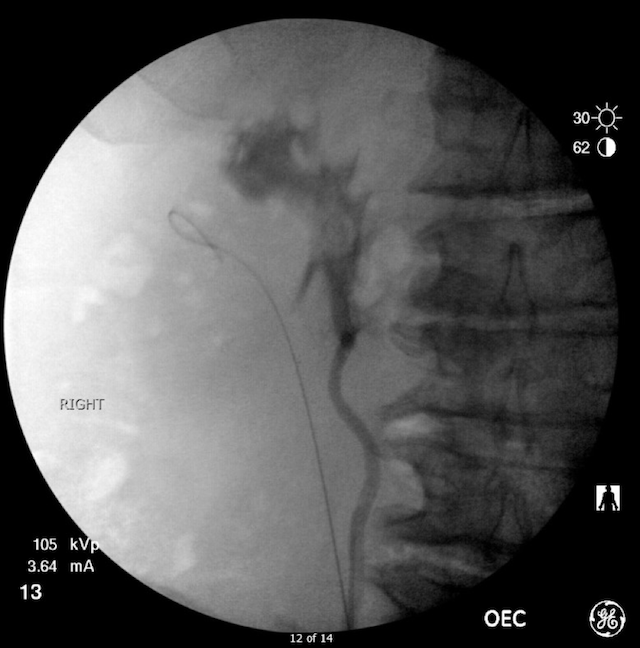Article
Challenging cases in urology: Persistent ureteral stone in a 76-year-old male
An elderly male with hypertension, lumbar spinal stenosis, morbid obesity, and ED presents with acute right-sided worsening of his chronic back pain. A distal right ureteral stone is found on CT and his symptoms respond well to medical therapy, but he later develops severe right flank pain.


Dr. Fascelli is a urology resident and Dr. Gill is chief resident in the department of Urology, Glickman Urological and Kidney Institute, Cleveland Clinic Lerner College of Medicine, Education Institute, Cleveland.
History
A 76-year-old male with past medical history of hypertension, lumbar spinal stenosis, morbid obesity, and erectile dysfunction presented to an emergency department with acute right-sided worsening of his chronic back pain. He was subsequently found to have a 7-mm obstructing right distal ureteral stone accompanied by hydroureteronephrosis on abdominal computed tomography (CT) imaging. He then underwent cystoscopy and right ureteral stent placement.
Following this episode of care at an outside institution, he presented to the emergency department at our hospital 1 week later with intractable right flank pain. He had no history of nephrolithiasis or urinary tract pathologies.
Examination
The patient was an obese and elderly gentleman, who appeared consistent with stated age and in mild distress. He was afebrile with normal vital signs. He did not have a leukocytosis, and his urinalysis revealed mild hematuria. Imaging from his recent encounter was unavailable. Outside records from his recent encounter were unavailable. Therefore, a stone-protocol abdominopelvic CT was obtained and revealed a well-placed stent, stable lower pole cyst, no hydroureteronephrosis, and a distal right ureteral stone that measured 8 mm by 9 mm and appeared to be crowning into the bladder (figure 1). His symptoms responded well to medical therapy and he was discharged with plans for outpatient follow-up, including surgical planning.
Figure 1. Axial CT scan image with distal right ureteral stone that measured 8 mm by 9 mm (red arrow) adjacent to right ureteral stent. (Photo courtesy of Michele Fascelli, MD, and Bradley C. Gill, MD, MS)
Four days later, however, he returned to the office complaining of severe right flank pain without nausea, emesis, fevers, lower urinary tract symptoms, or hematuria. Concern for failed trial of passage and possible re-obstruction of the right upper tract were discussed. This prompted consent and planning for endoscopic management. Further imaging prior to this was not considered in light of the patient presentation and recent imaging obtained.
Next: What's your diagnosis?
Discussion and diagnosis
At the time of cystoscopy, bilateral orthotopic ureteral orifices were noted with a stent emerging from the right ureteral orifice and bulging at the right hemi-trigone, consistent with a stone in the intramural ureter. A wire was placed alongside the previously placed stent and advanced under fluoroscopic guidance. The stent was then removed and a retrograde ureteropyelogram was performed (figure 2A).
The study appeared consistent with the drooping lily sign, raising suspicion for a duplicated collecting system. A flexible ureteroscope was advanced over the wire and into the renal pelvis under fluoroscopic guidance. No ureteral stone was observed and systematic pyeloscopy did not reveal any nephroliths.
Attention was returned to the bladder, and after some time, thorough inspection revealed a pinpoint ostium medial to the previously stented right ureteral orifice. This was successfully accessed with a wire and cannulated with a 5F ureteral catheter. A retrograde ureteropyelogram was obtained and revealed a large ureterocele (figure 2B). The second ureter drained an upper pole moiety of the right collecting system (figure 2C).

Figure 2A. Retrograde ureteropyelogram of the lower pole moiety demonstrating the drooping lily sign.

Figure 2B. Retrograde ureteropyelogram of the upper pole moiety with large ureterocele. (Photo courtesy of Michele Fascelli, MD, and Bradley C. Gill, MD, MS)

Figure 2C. Opacified upper pole moiety with wire in the lower pole moiety. (Photo courtesy of Michele Fascelli, MD, and Bradley C. Gill, MD, MS)The ureteroscope was advanced over a wire into the upper pole ureter and the stone was immediately encountered within the ureterocele. Using laser lithotripsy, the stone was fragmented and successfully removed. Pyeloscopy of the upper pole moiety revealed no further nephroliths. A stent was placed in the upper pole moiety per standard practice of the surgeon and uneventfully removed in the office thereafter.
The drooping lily sign is a uroradiographic hallmark of a duplicated renal collecting system. It refers to the inferolateral displacement of the opacified lower pole moiety due to an obstructed upper pole moiety (Clin Radiol 1976; 27:521-30). The lower pole moiety often has a small number of calyces, giving it the appearance of a narrow and conically shaped lily. Classically, duplicated systems follow the Weigert-Meyer law: the upper pole moiety terminates in the more inferomedial orifice and is at risk of obstruction by ureterocele, while the lower pole moiety terminates in the more superolateral orifice and is prone to vesicoureteral reflux secondary to a shorter intramural ureteral length (Radiographics 1997; 17:109-27).
While the detection of renal anomalies has increased in childhood secondary to routine fetal imaging, in adults there is a notable prevalence of undiagnosed upper tract anomalies, which are detected incidentally on abdominal imaging or at the time of surgery (Clin Radiol 1976; 27:521-30). The estimated prevalence of a duplicated renal collecting system ranges between 0.3% and 6% (Zissin et al). This congenital anomaly places patients at increased risks of recurrent urinary tract infections and pyelonephritis, which typically present with flank pain and hematuria (Clin Radiol 2001; 56:58-63). Imaging in patients with hydronephrosis of duplicated upper tracts can mimic the appearance of a simple cyst; therefore, a duplicated system should be considered on the differential when evaluating these patients (JRSM Short Rep 2013; 4[2]:13).
Next: Not a pediatric abnormality
Conclusion
Duplicated renal collecting systems and other structural renal abnormalities, albeit more clinically significant in the pediatric population, represent anatomic variants that may influence the treatment of urologic conditions. A thorough history and physical examination, broad differential diagnosis, and surgical scrutiny can help minimize the diagnostic challenges presented by duplicated upper tracts in adults.
To get weekly news from the leading news source for urologists, subscribe to the Urology Times eNews.

















